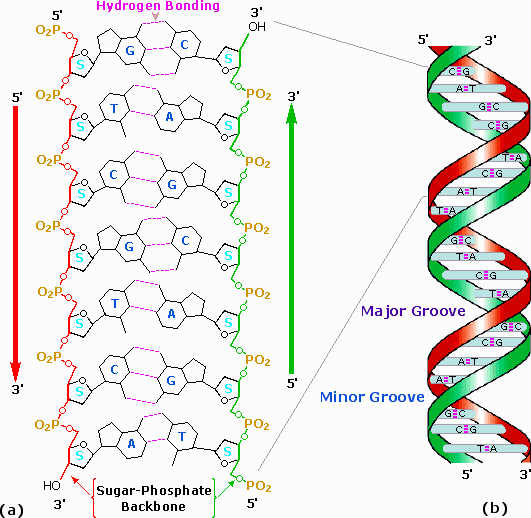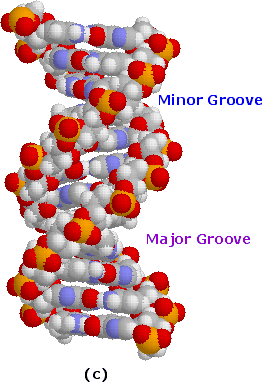


 علم الكيمياء
علم الكيمياء 
 الكيمياء التحليلية
الكيمياء التحليلية 
 الكيمياء الحياتية
الكيمياء الحياتية 
 الكيمياء العضوية
الكيمياء العضوية 
 الكيمياء الفيزيائية
الكيمياء الفيزيائية
 الكيمياء اللاعضوية
الكيمياء اللاعضوية 
 مواضيع اخرى في الكيمياء
مواضيع اخرى في الكيمياء
 الكيمياء الصناعية
الكيمياء الصناعية |
Read More
Date: 25-12-2019
Date: 27-12-2019
Date: 24-8-2018
|
After many trials and modifications, Watson and Crick conceived an ingenious double helix model for the secondary structure of DNA. Two strands of DNA were aligned anti-parallel to each other, i.e. with opposite 3' and 5' ends , as shown in part a of the following diagram. Complementary primary nucleotide structures for each strand allowed intra-strand hydrogen bonding between each pair of bases. These complementary strands are colored red and green in the diagram. Coiling these coupled strands then leads to a double helix structure, shown as cross-linked ribbons in part b of the diagram. The double helix is further stabilized by hydrophobic attractions and pi-stacking of the bases. A space-filling molecular model of a short segment is displayed in part c on the right.
The helix shown here has ten base pairs per turn, and rises 3.4 Å in each turn. This right-handed helix is the favored conformation in aqueous systems, and has been termed the B-helix. As the DNA strands wind around each other, they leave gaps between each set of phosphate backbones. Two alternating grooves result, a wide and deep major groove (ca. 22Å wide), and a shallow and narrow minor groove (ca. 12Å wide). Other molecules, including polypeptides, may insert into these grooves, and in so doing perturb the chemistry of DNA. Other helical structures of DNA have also been observed, and are designated by letters (e.g. A and Z).
The Double Helix Structure for DNA

Space-Filling Molecular Model




|
|
|
|
علامات بسيطة في جسدك قد تنذر بمرض "قاتل"
|
|
|
|
|
|
|
أول صور ثلاثية الأبعاد للغدة الزعترية البشرية
|
|
|
|
|
|
|
قسم الشؤون الفكرية والثقافية يجري اختبارات مسابقة حفظ دعاء أهل الثغور
|
|
|